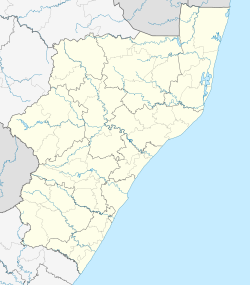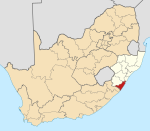|
Port Edward, South Africa
Port Edward is a small resort town situated on the south coast of KwaZulu-Natal in South Africa and lies on the border between KwaZulu-Natal and the Eastern Cape.[2] It is situated on the R61 road (future N2 Wild Coast Toll Route) between Port Shepstone and Lusikisiki. HistoryIn 1831 there was a crisis between the settlers in Port Natal (Durban) and Dingane, the Zulu king. Some settlers boarded a ship that was in the harbour and the others, including Henry Francis Fynn and his family, fled down the coast. The Zulu warriors caught up with them where Port Edward is today and massacred the fleeing settlers, which included local tribespeople of Langeni, on a hill called Isandlundlu (in English, shaped like a hut). The place has been known ever since as Tragedy Hill and its slopes are still littered with the bones of the victims. In 1552, the Portuguese carrack "Sao Joao" ran aground at Port Edward and this is the first time in recorded history that peoples from Europe met peoples from South Africa. In 1878, the ship "The Ivy" ran aground on Leisure Bay area beach. In 1925, the area was partly owned by TK Pringle,[3] and he named the inland portion Banner Rest as this was where he wished to "strike his banner". The village was laid out and was named Port Edward in honour of the Prince of Wales, who later became King Edward VIII.[3] The first holiday cottage in Port Edward was a shack built among the sand dunes in the early days by transport rider Edward Stafford. Unaware of their motility, however, he was surprised and dismayed to see his fine creation swallowed up. The area was subjected to several name changes as property was bought and sold, but the practice came to an end in 1852 when the town of Port Edward was ceremoniously dedicated to the then Prince of Wales.[4] GeographyLocationPort Edward is the southernmost town of KwaZulu-Natal and lies north of the Mtamvuna River which separates KwaZulu-Natal from the Eastern Cape. It is situated approximately 46 kilometres (29 mi) south-west of Port Shepstone by road and 153 kilometres (95 mi) south-west of Durban by road.[5][6] SuburbsThe 2011 census divided the main place of Port Edward into 16 “sub places” including:[7]
TourismPort Edward is a tourist resort for seasonal visitors from inland regions of South Africa. There are many tourist seasons that influence Port Edward but the most significant is the Christmas/ New Year period spanning from early December to mid-January. Port Edward's Silver Beach hosts an annual New Year's Eve party frequented by youths whilst on New Year's Day itself, families populate the beach for continued celebrations. Holiday accommodation is a particularly important source of income for the region throughout the year. BeachesBeaches in the greater Port Edward area include:
Attractions
Sardine RunAnother main season coincides with the Sardine run natural phenomenon usually occurring from late May to mid-July. SchoolsThere are various small schools in Port Edward, some consisting of only 50+ children; however the most popular of these schools is Port Edward Primary School. GolfThe 9-hole Port Edward Country Club is the main golf course in Port Edward. Nearby 18-hole golf courses include Wild Coast Sun, San Lameer, Southbroom Golf Club, Margate Country Club and Port Shepstone Country Club which are highly ranked by both Golf Digest and The Compleat Golfer.[22] TransportAirThe nearest airport is the Margate Airport approximately 32 km north-east of Port Edward. The airport offers one scheduled direct route to Johannesburg operated by CemAir. The nearest international airport is the King Shaka International Airport (KSIA) just north of Durban and is approximately 196 km north-east of Port Edward. KSIA offers regional flights to Southern Africa, intercontinental flights to the Middle East as well as many domestic flights.[23][24] RoadThe R61 is the main route that passes through Port Edward, connecting Port Shepstone with Mbizana and Mthatha. Izingolweni Road is a rural road connecting Port Edward with the N2 (to Kokstad) in Izingolweni to the north-west. See alsoReferences
External links |
||||||||||||||||||||||||||||||||||||||||||||||||||||||||
Portal di Ensiklopedia Dunia



